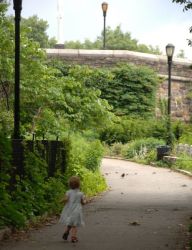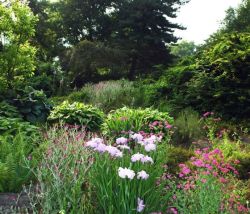Fort Tryon Park
The Cloisters
The Cloisters, a replica of a medieval monastery, rises from the towering cliffs of Fort Tryon Park in the Washington Heights section of northern Manhattan. A designated New York City landmark, it incorporates parts of actual Romanesque and Gothic cloisters from five medieval European monasteries, a Romanesque chapel, and a 12th-century Spanish apse. “Cloisters” refers to a place of religious seclusion, such as a monastery or a convent, as well as the covered walkways and courtyards that were included in the design of these holy places. In addition it houses an immense collection of medieval art.
The bulk of the collection originally belonged to George Grey Barnard (1863-1938). Barnard, a noted sculptor at the time, had amassed considerable debt and began to speculate and traffic in medieval antiquities, which he bought at reduced prices and sold abroad. Ruins from a portion of the Cuxa Cloister in France, now featured in the building's center, were purchased by Barnard for only $10,000, a paltry sum for an historical landmark. Barnard discovered the rest of the Cuxa ruins in a bathhouse in a French village and purchased them as well for just 5,000 French francs (not quite $1,000). Barnard had prepared the rest of the ruins for export to the United States, crating and cataloging the remnants, when French authorities realized that its historic national treasures were being pillaged. Under public pressure, Barnard returned the ruins to the village and quietly and quickly sent home the rest of his acquisitions just weeks before the French government passed legislation banning the international trading of historic monuments.
In 1914, Barnard built a gallery, known as The Cloisters, on Fort Washington Avenue to display his treasures. The Metropolitan Museum, with a $600,000 donation from John D. Rockefeller Jr. (1874-1960), purchased the collection in the 1920s. Rockefeller donated 62 acres of land he had purchased in 1909 for $1,700,000 and provided further funding to acquire additional land for Fort Tryon Park, setting aside four acres to build a second incarnation of the Cloisters. In exchange New York gave him land in the East 60’s for the Rockefeller Institute.
The surrounding park, with its neo-Gothic walls, structures, and battlements, was designed by the eminent landscape architect, Frederick Law Olmsted Jr. Charles Collens (1873–1956), who designed Riverside Church, drew up the plans, and The Cloisters opened to the public in 1938. The medieval structure was built using quarried granite cut into smaller, more manageable blocks in order to duplicate ancient Roman building methods, eschewing any benefits of modern technology.
The exterior of the building is a conglomerate of architectural styles, which range from Romanesque to late Gothic. It is dominated by the Cuxa Cloister tower, which holds the Cuxa Cloister that Barnard took from France; the tower is a replica of the cloister's original home and the building's roof tiles are similar to those found at the Cuxa site in France. A reconstructed Gothic cathedral on the building's southeast corner features 14th century stained glass and 13th and 14th century tomb monuments and pier sculptures. The Romanesque Langon Chapel, on the building's west side, contains part of the interior stonework from a 12th century church in southwestern France.
Inside, the building houses several European cloisters. The 12th century Romanesque apse in the Fuentidueña Chapel, on loan from the Spanish government, was taken apart and sent stone by stone to the United States in 1958. It was reassembled and opened to the public in 1961. Rockefeller himself donated a set of Gothic tapestries from a chateau in France recounting the "Hunt of the Unicorn." The tapestries are one of the most popular attractions, and have become a signature piece for The Cloisters. Also featured are interior courtyards with lovely and gardens and sculptures oriented to invite peaceful introspection. The Cloisters was designated an official New York City landmark in 1974.
Check out your park's Vital Signs
Clean & Safe
Green & Resilient
Empowered & Engaged Users
Share your feedback or learn more about how this park is part of a
Vital Park System









